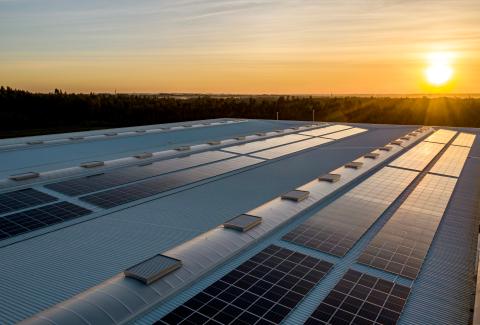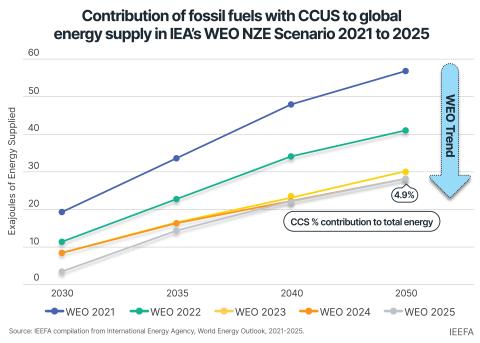IEEFA Update: As ExxonMobil Doubles Down on Oil and Gas, Investors Go Elsewhere
Even with the recent rebound in oil prices that accelerated after President Trump announced the U.S. would re-impose sanctions against Iran, energy companies no longer dominate the stock market like they once did.
In 1980, seven of the ten largest companies in the S&P 500 were oil companies. Today, ExxonMobil is the only remaining oil company in the top ten, and six are technology corporations. The energy sector now comprises roughly 6% of total S&P market capitalization, down from over 16% in 2008.
While investors are leaving the energy sector as a whole, they’re also dramatically shifting their holdings in the oil and gas sector. Investors are now demanding that companies either exercise “capital discipline” (code for limiting spending on new oil and gas projects) or actively pivot toward a low-carbon future.
But Exxon has done the opposite, doubling down on new oil and gas projects around the world, despite having taking impairments on past oil and gas investments. Pick a continent, any continent, and Exxon plans to drill there for oil or gas. The company appears to have no belief in—and no plans for—a low-carbon future. Indeed, its outlook has oil demand continuing to rise through 2040.
Based on Exxon’s stock price compared to the other oil majors (see the screenshot below), investors mistrust the company’s vision of the future or its ability to execute that vision. It’s no wonder, given Exxon’s massive write-offs of failed investments, including the nearly 4-billion-barrel tar sands write-off in 2016 and ongoing losses related to the company’s ill-timed investment in natural gas. (Exxon’s 2010 acquisition of XTO Energy when natural gas was $5/Btu, compared to the current price of $2.75/Btu illustrates the latter.)
IN 2017, THE COMPANY MISSED BOTH ITS REVENUE AND EARNING PROJECTIONS, even though oil prices rose. In its first-quarter report for this year, Exxon conceded it had also missed production targets. No wonder investors have grown increasingly skeptical of management’s ability to make capital investments that will last decades.
By contrast, oil majors including Total and British Petroleum have signaled they want to embrace, and benefit from, a low-carbon energy economy. Earlier this month, Total announced plans to increase its low-carbon assets to 20% of its holdings through a $1.7 billion stake in a French electricity retailer, Direct Energie. And British Petroleum’s top executives have committed to restraining capital expenditures in 2018 while making aggressive plans for renewable energy investments.
Shares in oil majors other than Exxon—Chevron, Shell, BP, Total and ConocoPhillips— have risen 25-60% in the past two years, while Exxon’s stock price has dropped more than 10% against the broader stock market gain of 30%. Its return on invested capital has declined from 31% in 2005, to 16% in 2014, to 7% in 2017.
MACROECONOMICALLY SPEAKING, EXXON’S FALL FROM INVESTORS’ GRACE is related to three converging trends: the ongoing global energy-sector transition, the preeminence of technology companies and a generational wealth transfer.
When pressed by a majority of shareholders to address how technological advances and global climate-risk policies will affect its business, the company issued a head-in-the sand climate risk report we concluded was defective, unresponsive and inadequate.
Meanwhile, the growth of technology companies has captured the imagination—and dollars—of investors seeking to own a stake in a future they perceive as increasingly driven by companies like Amazon, Apple and Google.
Exxon’s underperformance may also signal that divestment from fossil fuels has accelerated. The largest generational wealth transfer in history is under way, and Baby Boomers are expected to leave $30 trillion to heirs who prize good corporate citizenship.
Wall Street is actively courting these young investors, who are said to be aligning their investments with their values (half of Exxon’s investors are individuals, a larger percentage than for most big companies). In no small part, shareholders may be leaving because of Exxon’s persistently contentious relationship with law enforcement, and its insistence on waging a campaign against those who raise questions about climate risk.
Exxon’s strategy is a bet on the past. But investors are looking to the future.
Tom Sanzillo is IEEFA’s director of finance. Kathy Hipple is an IEEFA guest columnist and finance professor at Bard College’s MBA program in sustainability.
RELATED ITEMS:
IEEFA Update: ExxonMobil’s Empty Climate-Risk Report
IEEFA Op-Ed: Shareholders Need Not Be in Denial Like ExxonMobil Is
IEEFA Update: Red Flags Around ExxonMobil’s Q4 and 2017 Earnings















